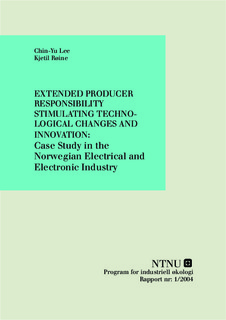| dc.description.abstract | Technology plays an essential role in all industrial activities. When different technologies bring comfort and convenience to our lives, the rapid material consumption also results in various forms of environmental deterioration. Gradually, it is realized that pushing technological development in an environmentally-friendly direction is an important task, and public policy is one of the major driving forces.
Among various types of environmental policies, extended producer responsibility (EPR) is a relatively new and market-oriented approach. OECD (2001) defines it as “an environmental policy approach in which a producer’s responsibility, physical and/or financial, for a product is extended to the post-consumer stage of a product’s life cycle”. When resources are drawn from the upstream actors, i.e. the producers, to the downstream waste management activities, there exists potential for innovation to occur at both sides. The producers may make product changes in order to reduce their cost, and the waste managers receive more support, either financial subsidies or an enlarged market for example, to have their job done.
In this paper, we aim to look for empirical evidence regarding how EPR stimulates technological changes. In Norway, some EPR policy instruments have come into force for the electrical and electronic (EE) industry since 1999: the EE Regulation and the EE Covenant. To fulfill their obligations accordingly, the Norwegian producers have collectively set up a national return system for their end-of-life products and pay a fee when introducing new products in the market to producer responsibility organizations (PROs), who then take over the physical responsibility to coordinate the collection and treatment of scrapped EE products. At the moment, there are three major PROs in the Norwegian EE industry.
At the EU level, two directives regarding EE products were promulgated in October 2002: the Directive on waste electrical and electronic equipment (the WEEE Directive) and the Directive on the restriction of the use of certain hazardous substances in electrical and electronic equipment (the RoHS Directive). The former requires producers to take back and recycle their waste, while the latter basically demands that new EE products should not contain six hazardous substances.
The above-mentioned domestic and international policy instruments, together with some others, bind on the Norwegian EE industry. It is then of our research interest to find out whether these EPR instruments have driven technological change among actors in the sector. A web-based survey entitled “Green” technological changes in the Norwegian EE sector was conducted. 71% answered “yes” when asked whether there have been technological changes in the products or processes during the last 10 years to deal with environmental problems. Based on those who answered yes, the driving forces were identified as: “environmental regulations in EU” (68%), “environmental awareness and commitment in the organization” (59%), “environmental regulations in Norway” (55%), and “market demand” (50%).
In spite of the survey results, interviews with staff from PROs and industry associations revealed that the upstream actors in the Norwegian EE industry are not yet very active in carrying out environmentally-friendly product changes. Reasons to this can be that, first, Norway is only a small market with no big producers, and second, there is no clear mechanism to stimulate “green products” in the pricing structure of the collective scheme. However, the implementation of the RoHS Directive drew rather high attention and participation from the producers to remove focal substances from their products.
Though the Norwegian national EPR scheme does not bring out much of the upstream actors, the resources that are collected and flow into waste management motivate the downstream actors. To date, several EE waste treatment plants can be found national-wide. They are preoccupied to find technological solutions to process tricky EE products and increase their process efficiency.
Three company cases were selected to be closely examined, in order to see the mechanism of policy influence. In Osram AS, lead was removed from their production of incandescent lamps, and the RoHS Directive was the main cause. Research activities in the mother company even started some years before the directive was finally promulgated. WEEE Recycling AS put together “the most modern recycling plant in the world” for EE waste, and Elektronikkgjenvinning AS possessed “the world’s first facility capable of processing SF6” from some sealed-forlife electrical switch gears. For these process changes, the Norwegian EPR regulations have everything to say. | nb_NO |
